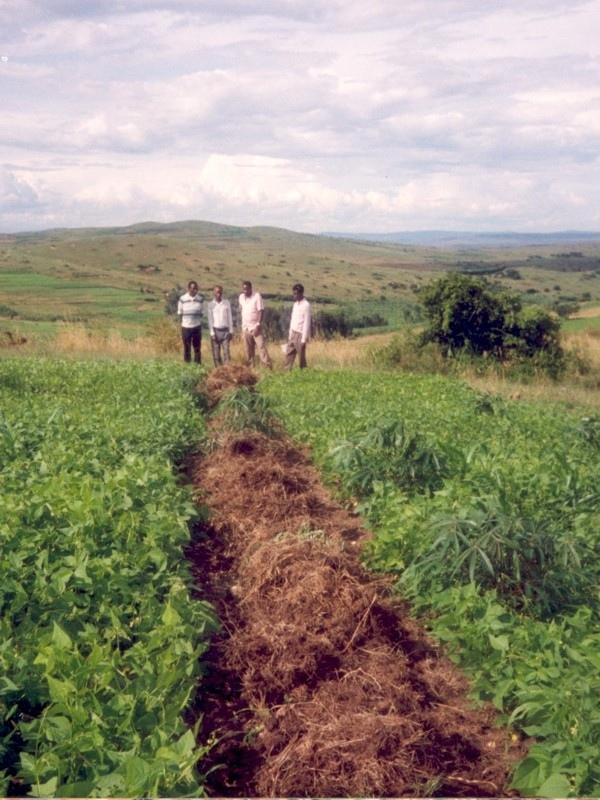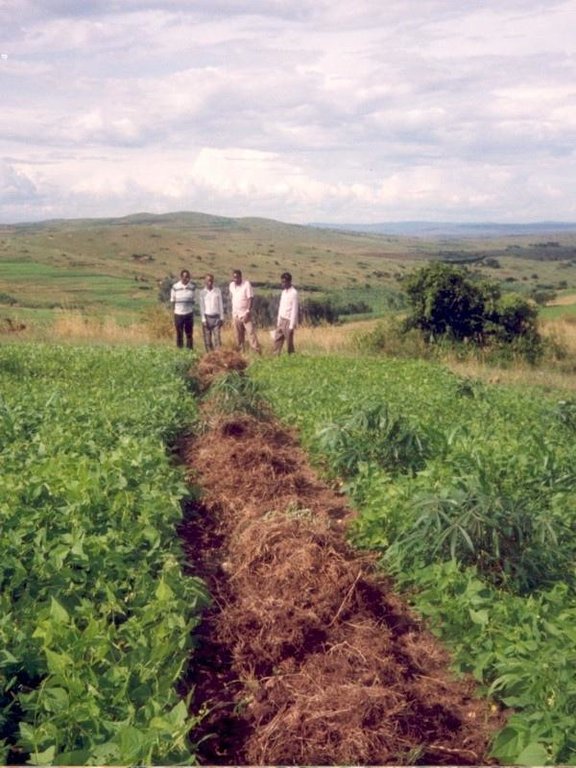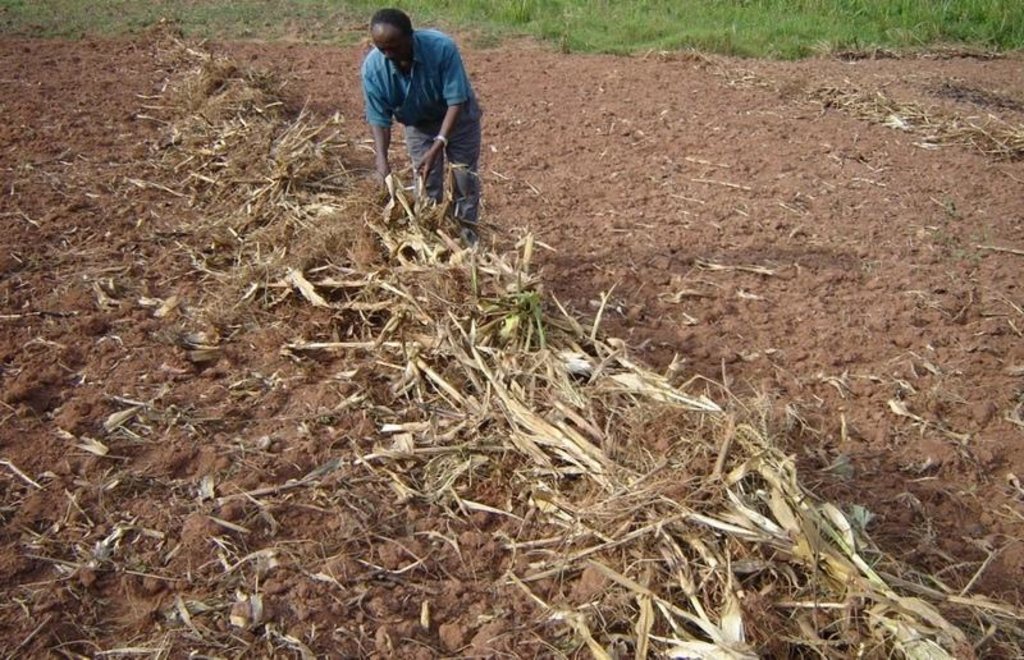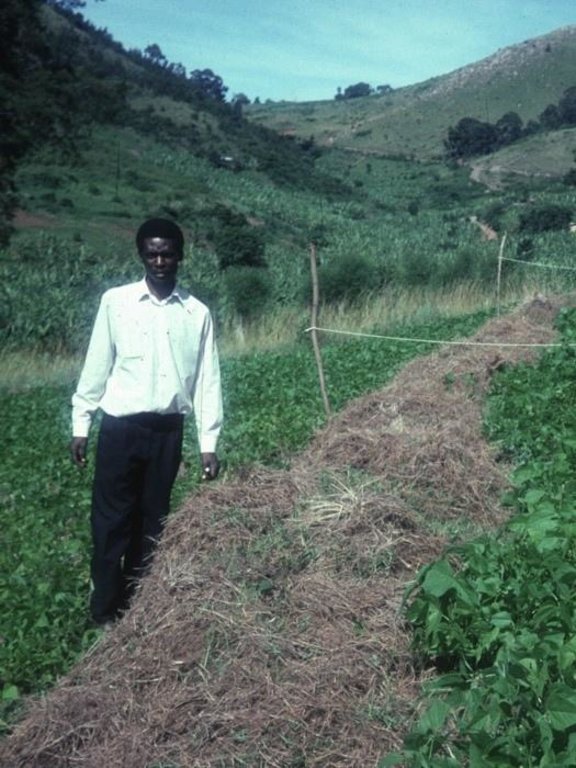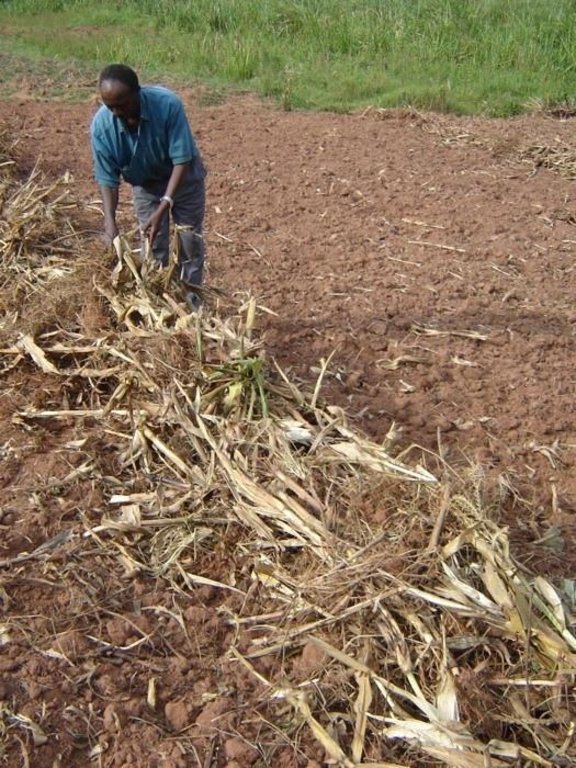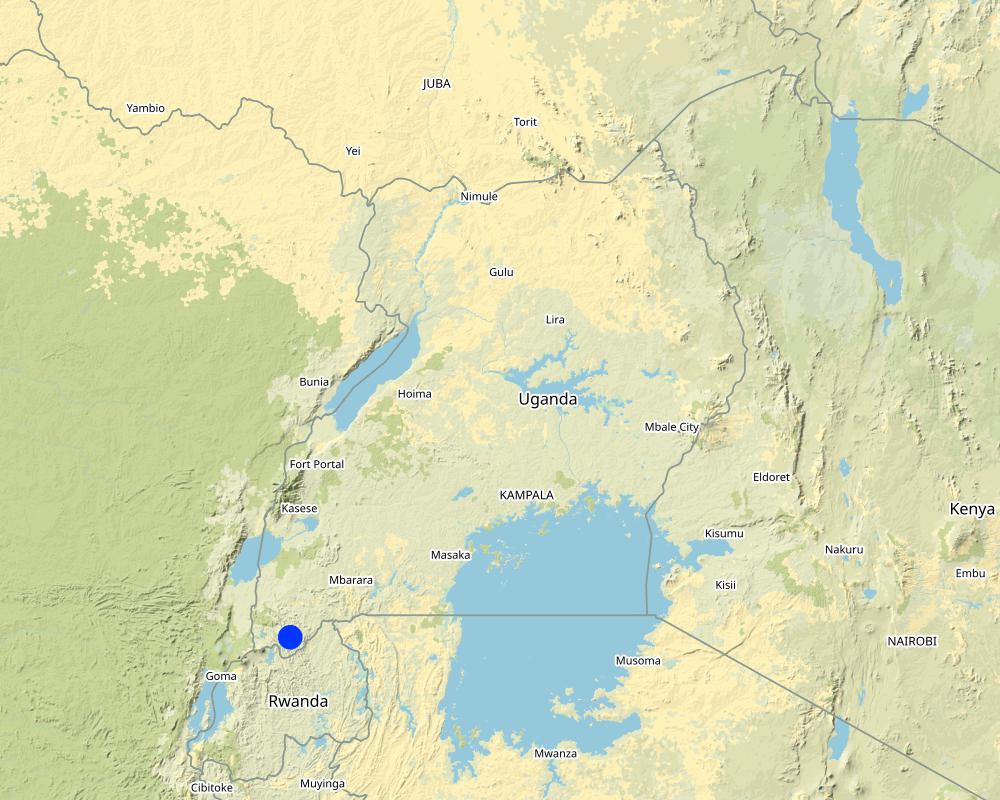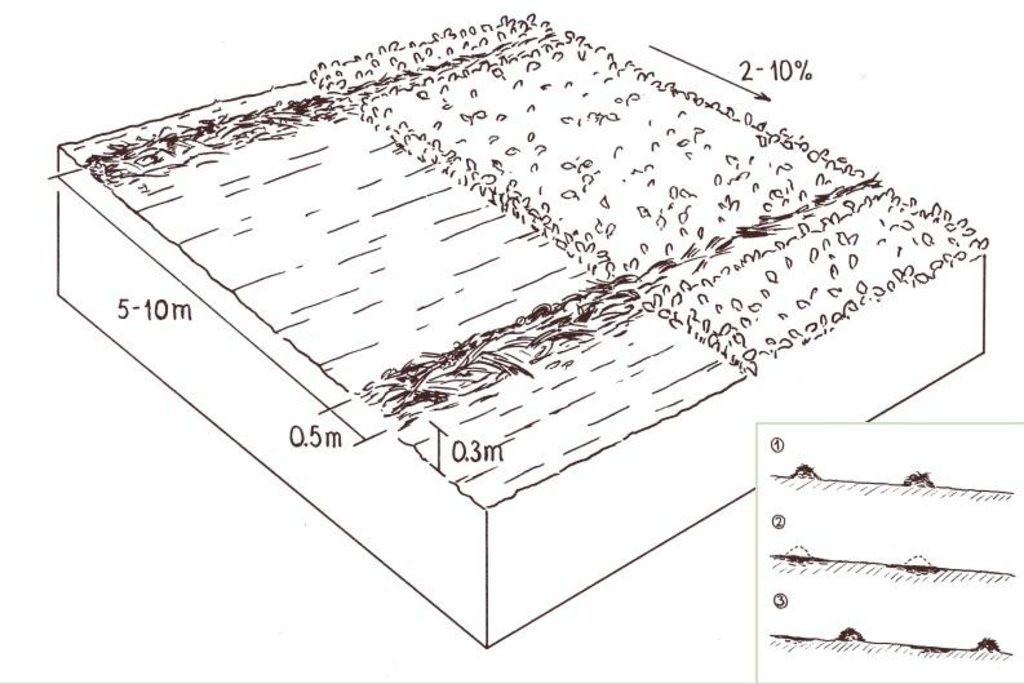Improved trash lines [اوغندا]
- تاريخ الإنشاء:
- تحديث:
- جامع المعلومات: Unknown User
- المحرر: –
- المراجعون: Alexandra Gavilano, Fabian Ottiger, Joana Eichenberger
Emikikizo (Lukiga)
technologies_990 - اوغندا
عرض الأقسام
توسيع الكل طي الكل1. معلومات عامة
1.2 تفاصيل الاتصال بالأشخاص الرئيسيين لمصدر المعلومات والمؤسسات المشاركة في تقييم وتوثيق التقنية
الشخص (الأشخاص) الرئيسي لمصدر المعلومات
متخصص في الإدارة المستدامة للأراضي:
Miiro Henry Dan
Ministry of agriculture animal industry and fisheries - Uganda
اوغندا
اسم المشروع الذي سهّل توثيق/تقييم التقنية (إذا كان ذلك على صلة)
Book project: where the land is greener - Case Studies and Analysis of Soil and Water Conservation Initiatives Worldwide (where the land is greener)اسم المؤسسة (المؤسسات) التي سهلت توثيق/تقييم التقنية (إذا كان ذلك على صلة)
Ministry of Agriculture, Animal Industry, and Fisheries of Uganda (MAAIF) - اوغندا1.3 الشروط المتعلقة باستخدام البيانات الموثقة من خلال WOCAT
يوافق جامع المعلومات والشخص (لاشخاص) الرئيسي لمصدر المعلومات على الشروط المتعلقة باستخدام البيانات الموثقة من خلال WOCAT:
نعم
1.5 الإشارة إلى الاستبيان (الاستبيانات) حول مناهج الإدارة المستدامة للأراضي (موثقة باستخدام WOCAT)
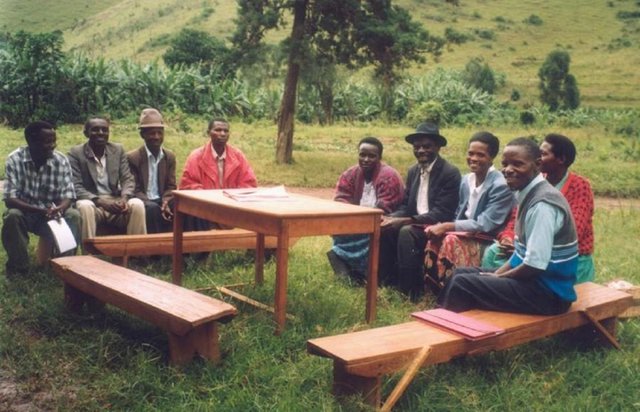
Promoting farmer innovation [اوغندا]
Identification of farmer innovators in SWC and water harvesting, and using them as focal points for visits from other farmers to spread the practices and stimulate the process of innovation.
- جامع المعلومات: Kithinji Mutunga
2. وصف تقنيةالإدارة المستدامي للأراضي
2.1 وصف مختصر للتقنية
تعريف التقنية:
Weeds and crop residues laid in bands across the slope of annual crop fields to conserve soil and water, and to incorporate organic matter into the soil after decomposition.
2.2 وصف تفصيلي للتقنية
الوصف:
Trash lines of organic material across the slope constitute a traditional land husbandry practice in south-west Uganda. These traditional, ‘unimproved’, trash lines are beneficial, but even better is an improved version designed through Participatory Technology Development (PTD). Improved trash lines are smaller, closer spaced, and of longer duration than the traditional type. They are more effective in controlling runoff and maintaining soil fertility.
All trash lines (improved and traditional) are composed of cereal stover (straw) and weeds that are collected during primary cultivation (hand hoeing), and heaped in strips along the approximate contour. Creeping grasses should not be used in trash lines: they can alternatively be decomposed in bundles, and then used as mulch in nearby banana plantations. Trash lines are used in hillside fields where annual crops, including sorghum, finger millet, beans and peas, are grown. The recommended spacing between the improved trash lines is 5-10 m, depending
on the slope: the steeper the closer. The amount of material available determines the cross section of each trash line (typically ±0.5 m wide and ±0.3 m high). Improved trash lines are left in place for four seasons (there are two seasons a year in Kabale) before they are dug into the soil. Much of the material used has, by this time, decomposed or been eaten by termites. Through incorporation into the topsoil, they improve soil fertility acting effectively as ‘mobile compost strips’. New trash lines are then established between the sites of the former lines. Upkeep comprises removal of weeds that sprout within the lines - before they set seed - and the addition of more trash during each new cultivation and weeding cycle.
Improved trash lines are multipurpose in retarding dispersed runoff while, as discussed, maintaining soil fertility. They are a low-cost option for soil and water conservation. However, they need to be complemented by other measures on the steeper slopes. The climate in this part of Uganda is subhumid, with a bimodal rainfall regime, and average annual rainfall of around 800 mm. Hill tops are used for grazing, the lower slopes are cultivated with annual crops (where the trash lines are found) and the valleys are dedicated to bananas and other cash crops. Families are large: 8-10 persons, and the population density is high, at nearly 200 persons/km2.
2.3 صور التقنية
2.5 البلد/المنطقة/المواقع التي تم تنفيذ التقنية فيها والتي يغطيها هذا التقييم
البلد:
اوغندا
المنطقة/الولاية/المحافظة:
Kabale
مزيد من التفاصيل حول الموقع:
Kabale district
حدد انتشار التقنية:
- منتشرة بالتساوي على مساحة
إذا كانت المساحة الدقيقة غير معروفة، فيرجى الإشارة إلى المنطقة التقريبية المغطاة:
- 0.1-1 كم2
التعليقات:
Total area covered by the SLM Technology is 0.25 km2.
it is an indeginous technology. Widely used in various fields and at different slopes.
Map
×2.6 تاريخ التنفيذ
في حالة عدم معرفة السنة بالتحديد، يرجى الإشارة إلى التاريخ التقريبي:
- منذ أكثر من 50 عامًا (تقليدي)
2.7 إدخال التقنية
حدد كيف تم إدخال التقنية:
- كجزء من النظام التقليدي (> 50 عامًا)
3. تصنيف تقنية الإدارة المستدامي للأراضي
3.1 الغرض الرئيسي ( الأغراض الرئيسية) للتقنية
- تحسين الإنتاج
- الحد من تدهور الأراضي ومنعه وعكسه
- التكيف مع تغير المناخ/الظواهر المتطرفة وآثارها
3.2 نوع (أنواع) استخدام الأراضي الحالية حيث يتم تطبيق التقنية

الأراضي الزراعية
- زراعة سنوية
- زراعة معمرة (غير خشبية)
- زراعة الأشجار والشجيرات
الزراعة السنوية - حدد المحاصيل:
- الحبوب - الدخن
- الحبوب - الذرة الرفيعة
- الحبوب البقولية والبقول- الفاصوليا
- الحبوب البقولية والبقول- البازلاء
الزراعات المعمرة (غير الخشبية) - حدد المحاصيل:
- الموز/موز الهند/الأباكا
- Eucalyptus
عدد مواسم الزراعة في السنة:
- 2
حدد:
Longest growing period in days: 180 Longest growing period from month to month: Feb - Jul Second longest growing period in days: 120 Second longest growing period from month to month: Sep - Jan
التعليقات:
Major land use problems (compiler’s opinion): Continuous cultivation of annual crops on slopes prone to erosion, with little or no restitution of fertility through manures
or fertilizers.
Major land use problems (land users’ perception): continous cultivation without fallow due to small sizes of farms
3.4 إمدادات المياه
إمدادات المياه للأرض التي يتم تنفيذ التقنية عليها:
- بعلية
3.5 مجموعةالإدارة المستدامة للأراضي التي تنتمي إليها هذه التقنية
- تحسين الغطاء الأرضي/النباتي
- التدابير المتقاطعة للمنحدرات
- حصاد المياه
3.6 التدابير التقنية في مجال إلادارة المستدامة للأراضي
3.7 الأنواع الرئيسية من تدهور الأراضي التي تناولتها التقنية

تآكل التربة بالمياه
- الوزن(Wt): فقدان التربة السطحية/تآكل السطح

التدهور الكيميائي للتربة
- (Cn): تراجع الخصوبة وانخفاض محتوى المادة العضوية (غير ناتج عن الانجراف)

تدهور المياه
- (Ha): التجفيف
التعليقات:
Main type of degradation addressed: Wt: loss of topsoil / surface erosion, Cn: fertility decline and reduced organic matter content
Main causes of degradation: other human induced causes (specify) (lack of communication), education, access to knowledge and support services (lack of spread of knowledge)
3.8 منع أو حد أو عكس تدهور الأراضي
تحديد هدف التقنية فيما يتعلق بتدهور الأراضي:
- منع تدهور الأراضي
- الحد من تدهور الأراضي
التعليقات:
Main goals: mitigation / reduction of land degradation
Secondary goals: prevention of land degradation
4. المواصفات الفنية، وأنشطة التنفيذ، والمدخلات، والتكاليف
4.1 الرسم الفني للتقنية
المواصفات الفنية (المتعلقة بالرسم الفني):
Trash lines without crops (left)
and with crops (beans; right).
The insert shows the stages of the technology: regularly spaced trash lines are kept place for four seasons (1); then decompose over time and are incorporated into the soil (2); and finally new trash lines are placed between the previous strips (3).
Technical knowledge required for field staff / advisors: low
Technical knowledge required for land users: low
Main technical functions: control of dispersed runoff: impede / retard, increase of infiltration, increase in soil fertility
Secondary technical functions: control of dispersed runoff: retain / trap, increase in organic matter, improvement of soil structure, sediment harvesting
Agronomic measure: mulching, trash lines
Material/ species: weed residue, sorghum
Remarks: along contour
المؤلف:
Mats Gurtner
4.2 معلومات عامة بخصوص حساب المدخلات والتكاليف
عملة أخرى/ عملة وطنية (حدد):
Uganda Shillings
إذا كان ذا صلة، وضح سعر الصرف من الدولار الأمريكي إلى العملة المحلية (على سبيل المثال، 1 دولار أمريكي = 79.9 ريال برازيلي): 1 دولار أمريكي =:
1000,0
اذكر متوسط تكلفة أجر العمالة المستأجرة في اليوم الواحد:
1.00
4.4 التكاليف والمدخلات اللازمة للتأسيس
| تحديد المدخلات | الوحدة | الكمية | التكاليف لكل وحدة | إجمالي التكاليف لكل مدخل | % من التكاليف التي يتحملها مستخدمو الأراضي | |
|---|---|---|---|---|---|---|
| العمالة | Labour | ha | 1,0 | 25,0 | 25,0 | 100,0 |
| معدات | Tools | ha | 1,0 | 5,0 | 5,0 | 100,0 |
| إجمالي تكاليف إنشاء التقنية | 30,0 | |||||
| إجمالي تكاليف إنشاء التقنية بالدولار الأمريكي | 0,03 | |||||
التعليقات:
Duration of establishment phase: 36 month(s)
4.5 الصيانة/الأنشطة المتكررة
| النشاط | التوقيت/الوتيرة | |
|---|---|---|
| 1. | During land cultivation, existing (old) trash lines are dug. 2. New trash lines are then created exactly between the (cross-slope) | Dry season / each cropping season |
| 2. | The size of the trash lines depends on the amount of trash available, | Dry season |
| 3. | Weeds are added to the trash lines, and, in preparation for the second | Second season |
| 4. | Trash lines are kept free of growing weeds and built up with more | Third and fourth seasons |
| 5. | Trash lines are kept free of growing weeds and built up with moretrash. Full cycle for improved trash lines: 4 seasons (2 years) |
4.6 التكاليف والمدخلات اللازمة للصيانة/للأنشطة المتكررة (سنويًا)
التعليقات:
Machinery/ tools: hand hoe
These figures are approximate, representing a typical situation with 1,500 running metres of improved trash lines, per hectare, at a spacing of 7 m apart on a 10% slope. The 1st year (first and second seasons) involves more work than the
2nd year (third and fourth seasons): the figure given is an annual average of all work associated with trash lines. The costs of the traditional, larger and wider spaced trash lines are about 50% more than these given above - because trash has to be carried further.
4.7 أهم العوامل المؤثرة على التكاليف
قدم وصفا لأهم العوامل التي تؤثر على التكاليف:
Labour, need to collect and heap the trashlines material in lines above the slope
5. البيئة الطبيعية والبشرية
5.1 المناخ
هطول الأمطار السنوي
- < 250 مم
- 251- 500 ملم
- 501 - 750ملم
- 1,000-751 ملم
- 1,500-1,100 ملم
- 2,000-1,500 ملم
- 3,000-2,001 ملم
- 4,000-3,100 ملم
- > 4000 ملم
حدد متوسط هطول الأمطار السنوي (إذا كان معروفًا)، بالملليمتر:
800,00
المنطقة المناخية الزراعية
- شبه رطبة
Thermal climate class: tropics
5.2 طوبوغرافيا
متوسط الانحدارات:
- مسطح (0-2%)
- بسيط (3-5%)
- معتدل (6-10%)
- متدحرج (11-15%)
- تلال (16-30%)
- شديدة الانحدار(31-60%)
- فائقة الانحدار (>60%)
التضاريس:
- هضاب/سهول
- أثلام مرتفعة
- المنحدرات الجبلية
- منحدرات التلال
- منحدرات في السفوح
- قاع الوادي
المنطقة الارتفاعية:
- 100-0 متر فوق سطح البحر
- 500-101 متر فوق سطح البحر
- 1,000-501 متر فوق سطح البحر
- 1,500-1,001 متر فوق سطح البحر
- 2,000-1,501 متر فوق سطح البحر
- 2,500-2,100 متر فوق سطح البحر
- 3,000-2,501 متر فوق سطح البحر
- 4,000-3,001 متر فوق سطح البحر
- > 4000 متر فوق سطح البحر
التعليقات والمواصفات الإضافية بشأن التضاريس:
Slopes on average: Also rolling and hilling (both ranked 2)
5.3 التربة
متوسط عمق التربة:
- ضحل جدًا (0-20 سم)
- ضحلة (21-50 سم)
- متوسطة العمق (51-80 سم)
- عميقة (81-120 سم)
- عميقة جدًا (> 120 سم)
قوام التربة (التربة السطحية):
- متوسط ( طميي، سلتي)
المواد العضوية في التربة السطحية:
- متوسطة (1-3%)
- منخفضة (<1%)
إذا كان متاحًا، قم بإرفاق وصف كامل للتربة أو تحديد المعلومات المتوفرة، على سبيل المثال نوع التربة، الرقم الهيدروجيني/ درجة حموضة التربة، قدرة التبادل الكاتيوني، النيتروجين، الملوحة وما إلى ذلك.
Soil texture: Medium (the trash material modifies the organic matter content of the areas applied)
Soil fertility: Medium (ranked 1) and low (ranked 2)
Soil drainage/infiltration: Medium
Soil water storage capacity: Low (ranked 1) and medium (ranked 2)
5.6 خصائص مستخدمي الأراضي الذين يطبقون التقنية
التوجه السوقي لنظام الإنتاج:
- الكفاف (الإمداد الذاتي)
- مختلط (كفاف/ تجاري)
الدخل من خارج المزرعة:
- 10-50% من جميع الإيرادات
المستوى النسبي للثروة:
- ضعيف
- متوسط
مستوى المكننة:
- عمل يدوي
اذكر الخصائص الأخرى ذات الصلة لمستخدمي الأراضي:
1% of the land users are very rich and own 5% of the land.
5% of the land users are rich and own 10% of the land.
24% of the land users are average wealthy and own 50% of the land.
55% of the land users are poor and own 25% of the land.
Off-farm income specification: some farmers are involved in trade with nearby Rwanda and there are also a number of families who receive remittances from family members who work in Kabale or as far away as Kampala
5.7 متوسط مساحة الأرض التي يستخدمها مستخدمو الأراضي الذين يطبقون التقنية
- < 0.5 هكتارا
- 0.5 - 1 هكتار
- 1 -2 هكتار
- 2 - 5 هكتار
- 5 - 15 هكتار
- 15 - 50 هكتار
- 50 - 100هكتار
- 500-100 هكتار
- 1,000-500 هكتار
- 10,000-1,000 هكتار
- > 10,000 هكتار
التعليقات:
Average area of land owned or leased by land users applying the Technology: Also 1-2 ha (ranked 2) and 2-5 ha (ranked 3)
5.8 ملكية الأراضي، وحقوق استخدام الأراضي، وحقوق استخدام المياه
ملكية الارض:
- فردية، لا يوجد سند ملكية
حقوق استخدام الأراضي:
- مجتمعي (منظم)
- فردي
6. الآثار والتصريحات الختامية
6.4 تحليل التكلفة والعائد
كيف تتم مقارنة العوائدمع كلفة الصيانة/التكاليف المتكررة (من وجهة نظر مستخدمي الأراضي)؟
عوائد قصيرة الأجل:
إيجابي
عوائد طويلة الأجل:
ايجابي جدا
6.5 اعتماد التقنية
التعليقات:
30 land user families have adopted the Technology without any external material support
Comments on spontaneous adoption: estimates
There is a moderate trend towards spontaneous adoption of the Technology
Comments on adoption trend: the technology is indeginous. There is some evidence of growing spontaneous adoption.
6.7 نقاط القوة / المزايا / الفرص التي توفرها التقنية
| نقاط القوة/ المزايا/ الفرص من وجهة نظر مستخدمي الأراضي |
|---|
|
Improved trash lines have small but significant advantages over the traditional trash lines (which are beneficial themselves) in terms of (a) less labour (b) improved crop performance How can they be sustained / enhanced? Continue with farmer-to-farmer visits for this to be explained. |
| نقاط القوة/ المزايا/ الفرص من وجهة نظر جامع المعلومات أو غيره من الاشخاص الرئيسيين لمصدر المعلومات |
|---|
|
The technology is very simple and uses locally available material. It is easy to understand, being a modification of an existing tradition How can they be sustained / enhanced? Continue with farmer-to-farmer visits for first hand learning. |
|
Multiple ecological and SWC benefits: improves soil fertility, reduces erosion, increases infiltration etc How can they be sustained / enhanced? Continue to encourage adoption of (and further farmer experimentation with) the improved trash lines. |
6.8 نقاط ضعف / مساوىء / مخاطر التقنية وسبل التغلب عليها
| نقاط الضعف/ المساوىء/ المخاطر من وجهة نظر مستخدم الأراضي | كيف يمكن التغلب عليها؟ |
|---|---|
| Source of weeds | Pull out weeds before they set seed and don’t use stoloniferous or rhizome-forming (creeping) grasses in trash lines (see picture). |
| trash line harbours pest and diseases | use entirely dry grass or material |
| نقاط الضعف/ المساوىء/ المخاطر من وجهة نظر جامع المعلومات أو غيره من الاشخاص الرئيسيين لمصدر المعلومات | كيف يمكن التغلب عليها؟ |
|---|---|
| Where land is limiting, agricultural land which would be used, is lost | uses it as a crop rotation basis |
| The trash lines are not enough on their own to control erosion on the steeper slopes | Introduce/promote supplementary structural remedies such as earth bunds. |
| Competition for crop residues which have an alternative use as livestock fodder and, especially, mulch in banana plantations | Grow hedgerows of shrubs/grasses to increase availability of material for fodder, trash lines and mulching. |
7. المراجع والروابط
7.1 طرق جمع/مصادر المعلومات
7.2 المراجع للمنشورات المتاحة
العنوان، المؤلف، السنة، النظام القياسي الدولي لترقيم الكتب ISBN:
Briggs SR et al. Livelihoods in Kamwezi, Kabale District, Uganda.. 1998.
متاح من أين؟كم التكلفة؟:
Silsoe Research Institute, UK
العنوان، المؤلف، السنة، النظام القياسي الدولي لترقيم الكتب ISBN:
Mutunga K and Critchley W. Farmer’s initiatives in land husbandry Technical Report No 27. 2001.
متاح من أين؟كم التكلفة؟:
Regional Land Management Unit, Nairobi, Kenya
العنوان، المؤلف، السنة، النظام القياسي الدولي لترقيم الكتب ISBN:
Critchley W and Mutunga K .Local innovation in a global context: documenting farmer initiatives in land husbandry through WOCAT Land Degradation and Development (14) pp 143–162. 2003.
الروابط والوحدات المواضيعية
توسيع الكل طي الكلالروابط

Promoting farmer innovation [اوغندا]
Identification of farmer innovators in SWC and water harvesting, and using them as focal points for visits from other farmers to spread the practices and stimulate the process of innovation.
- جامع المعلومات: Kithinji Mutunga
الوحدات المواضيعية
لا يوجد وحدات مواضيعية


